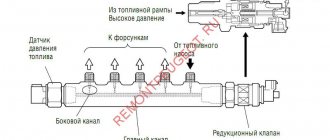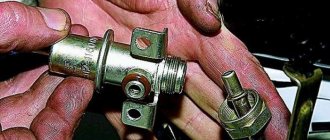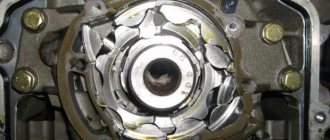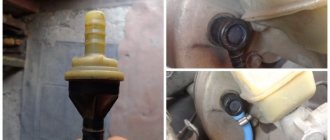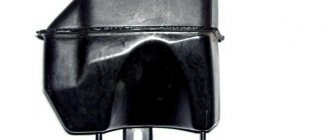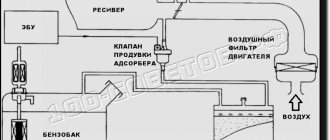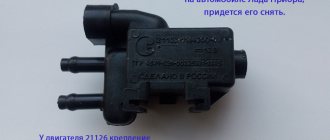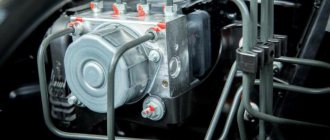Fuel system safety valve
It goes without saying that vehicle fuel systems are quite complex devices, which it is better not to approach without specific knowledge. On the other hand, knowledge of hardware and some experience is already considered as an opportunity to independently repair this or that defect. For example, if a fuel system check valve requires attention.
What is a check valve
The check valve in the fuel system should only allow fuel to flow in one direction. This is the main purpose of OKDT. When the fuel pump is not working, the device automatically closes the return fuel line to prevent unused fuel from flowing into the tank.
When the valves are working properly, the pressure in the main pipes does not drop for a long time after the engine stops. The small part is calibrated. The design consists of several elements:
- housing with outputs;
- ball-type valve with a seat made of soft metal;
- membrane;
- spring.
Comment!
Improving the starting characteristics of the internal combustion engine is the main function of the exhaust valve. A working part installed in a certain location in the fuel line maintains the optimal value of the residual pressure.
It is not difficult to understand how a valve installed on a ramp works:
- When the fuel injection pump is running, OKDT does not interfere with the movement of fuel in the forward direction.
- When the fuel pump turns off (when the engine stops), a reverse flow of working fluid occurs in the line.
- The reverse flow of fuel creates pressure, which closes the valve.
- The fuel remains in the line, creating residual pressure.
The operation of the entire fuel system of the vehicle depends on the small device. If there is no residual pressure in the line, it must be created every time the engine is started. The driver is forced to spend extra time cranking the starter.
How to find your device
There are models in which the valve is mounted in the fuel rail housing. A common installation location is the section of the fuel line located between the injectors and the tank.
There are vehicles in which the part is mounted directly into the fuel pump housing. In modern cars equipped with a fuel preheating system, the OKDT housing is located before the preheater. The installation location depends on the make of the machine:
| Brand, model) | Where is OKDT installed? |
| Renault Magnum | In between the fuel pumps |
| Tatra | |
| KAMAZ 740 | |
| Magnum trucks | Before the heating system |
| VAZ 2114 | Gasoline pump |
| VAZ 2110 (16-valve model) |
Reference! In older cars, the fuel pump was installed on the cylinder block. It was equipped with a sealed exhaust valve to prevent unused fuel from flowing back into the tank.
Why is OKDT confused with RDT?
Many car enthusiasts consider the fuel pressure regulator (FPR) to be a check valve. In fact, these are parts of different design and purpose. RTD valves come in two types:
- modulated by atmospheric pressure;
- vacuum-modulated.
Reference! The purpose of the RTD is to maintain a certain level of pressure in the pipes. It is installed in the fuel lines of two types of engines - diesel and injection. The pressure regulator valve always operates in parallel with the OKDT.
In vehicles with “return”, the mounting area of the pressure control valve is located on the fuel rail. It is located between the fuel rail and the return line. If the return line is not included in the circuit, the part is installed in the fuel tank housing. The performance of the injectors and the stable operation of the engine depend on the proper operation of the device.
Engine power supply system ZMZ-40524
Fuel supply is carried out through distributed fuel injection into the intake pipe in the area where the intake valves are located using four electromagnetic injectors operating according to a signal from a microprocessor control unit. Control unit depending on
engine operating mode changes the duration of opening of the fuel injectors.
Maintaining constant fuel pressure in the line to ensure guaranteed fuel supply to the injectors in all engine operating modes is ensured by a fuel pressure regulator. The fuel pressure regulator maintains a pressure of 392-408 kPa (3.92-4.08 kgf/cm 2 ) in the vehicle’s fuel system. The fuel pressure regulator together with the fuel level sensor are part of the submersible electric fuel pump module located in the fuel tank.
Symptoms of a problem
The following characteristic signs indicate a malfunction of the fuel system:
- after idle time the engine starts unstably;
- more fuel is consumed;
- smoke comes out of the exhaust pipe during acceleration;
- During maintenance, an increased content of CH and CO was recorded.
Signs of a faulty check valve in the fuel pump:
- the motor is unstable at minimum speed;
- to start the engine, you have to rotate the starter several times while simultaneously pressing the gas pedal;
- fuel hoses are leaking, tightening the clamps does not solve the problem;
- In idle mode the speed changes sharply.
Engine timing chain marks 405
When installing marks on the engine of a Gazelle car, experienced mechanics do not recommend turning the crankshaft counterclockwise. Timing timing marks are set according to the engine operating manual.
For example, the marks on the camshaft sprockets should be horizontal. They go in opposite directions from each other. The alignment of the timing marks along the upper plane of the cylinder head is maintained.
The marks are set so that the valves in the engine open and close in accordance with the phases that engineers have laid down in the ZMZ 405 motor. If there is a slight inaccuracy in setting the marks, this will lead to the fact that the valves may not open or close in time. Such behavior is fraught with destruction of the cylinder head and major overhaul of the entire engine.
Methods for diagnosing a malfunction
To independently check the return valve, measure the fuel pressure in different parts of the fuel system. To carry out diagnostics you need a pressure gauge. The measuring tool is connected to a specific section of the fuel line.
The measurement helps determine whether the RTD or check valve is faulty. If, when you turn off the ignition, the pressure value on the pressure gauge screen does not correspond to the reference value, then replacing the check valve of the fuel pump will help restore normal operation of the power unit.
Comment! Reference values in different sections of the fuel system: 3.2 bar is the norm for the fuel pump, for the fuel rail - 2-3 atm. A sharp drop in pressure is a sign of a malfunction.
Experienced car enthusiasts take measurements in the following sequence:
- connect the pressure gauge in the evening;
- The car is first started, then turned off;
- In the morning they check the pressure, compare it with the minimum value indicated in the book. If the pressure gauge shows less than normal, the check valve requires repair or replacement.
The second diagnostic method does not require measurements. It is used in case of unstable operation of the internal combustion engine, if the line through which the fuel is supplied is made of soft material.
During diagnostics, a hose is found through which the fuel moves in the opposite direction. They clamp the tube and at this moment evaluate how the motor works. If the operating mode of the cylinders corresponds to the norm, and the speed increases, it means that the valve does not hold pressure, it can be safely changed.
Why OKDT doesn't work
There are several reasons for the appearance of characteristic signs of a check valve malfunction. According to statistics, low-quality products most often fail. Counterfeits of well-known brands made in China do not work for a long time. Factory defects are a common cause of breakdown.
Comment! Bad gasoline harms all components of the fuel system: filters, pressure regulators, and check valves become unusable.
Wear of a part (depletion of its resource) is the second reason for the malfunction of the automobile fuel system. If the part is of high quality, then the first signs of OKDT malfunction occur when the mileage exceeds 100 thousand km. Quite often, mechanical structures break down due to low quality gasoline. Low-quality fuel may contain water and other impurities.
How to measure fuel rail pressure
You need a hose, a tee (plumbing), a pressure gauge up to 6 bar, several clamps. The pressure in the fuel rail is measured if, during acceleration, the engine operates with dips and unevenly.
In preparation for measurement, the hose is placed on the outlet fitting of the measuring device. To reduce the error and reduce pressure loss, the connection is fixed with a clamp. Carefully unscrew the plug and nipple from the fuel rail. Connect the second end of the hose and also secure it with a clamp. Blood pressure is measured in several modes.
| Measurement number | Mode | Normal pressure |
| 1 | With the ignition on | Not lower than 3 atm. |
| 2 | Idling | 2.5–2.7 atm. |
| 3 | The return pipe is pinched | More than 6 atm. |
| 4 | Gas pedal pressed | Decreases with gas overload from 3 to 2.5 atm. |
Site about off-road vehicles, SUVs, off-road vehicles
The fuel supply system for the ZMZ-40524 engine on Gazelle and Sable cars consists of a fuel tank, fuel lines, an electric fuel pump module with a fuel level sensor, a fine fuel filter, an engine fuel rail, and electromagnetic injectors.
Fuel supply system for the ZMZ-40524 engine on Gazelle and Sobol cars, composition, device, principle of operation.
Fuel is supplied through distributed injection into the intake channels of the cylinder head in the area where the intake valves are located using electromagnetic injectors operating according to a signal from the microprocessor control unit. The control unit, depending on the engine operating mode, changes the duration of opening of the fuel injectors.
Schematic diagram of the fuel supply system for the ZMZ-40524 engine on Gazelle and Sobol cars.
Maintaining constant fuel pressure in the line to ensure guaranteed fuel supply to the injectors in all engine operating modes is ensured by a fuel pressure regulator. The fuel pressure regulator maintains a pressure of 392-408 kPa (3.92-4.08 kgf/cm2) in the vehicle’s fuel system. The fuel pressure regulator together with the fuel level sensor are part of the submersible electric fuel pump module located in the fuel tank.
Troubleshooting methods
To replace a faulty part, select a spare part with a cross-section of the same size as the old device. If there is a discrepancy, the valve will start to skip. The installation location is chosen in the area between the filter and the fuel pump.
Comment! It’s easy to check the operation of a new part. They drive up a hill, if the power does not drop sharply, then the product fits perfectly.
In some car models, it is easier to change the fuel pump than to remove a faulty check valve. Usually such a solution is offered at service stations. Car enthusiasts who repair their cars themselves choose other options:
- wash the part from clogging with a powerful stream of water, use a car wash for this;
- remove dirt particles by lightly tapping the body;
- install another check valve on the fuel line.
If a “symptom” of a check valve malfunction appears, experts recommend diagnostics. It doesn’t matter where to do it - at a service station or on your own, the main thing is to find the cause of unstable engine operation and eliminate it in time.
Analogs
There are analogues on sale from various manufacturers - domestic and Chinese. It is possible to purchase a replacement chain separately or as a complete set. The price depends on the origin of the parts and the place of purchase. It is advisable to give preference to well-established auto shops.
| Name | vendor code | Price |
| Olmi | 406.1006040-20 | From 1,300 rubles |
| Miles | 040900100011801 | From 1,150 rubles |
| Ditton | 509105011801 | From 1 117 |
Examination
If you find characteristic symptoms, first we recommend that you make sure that the problem with the car is related specifically to this sensor.
The inspection is carried out as follows:
- At the end of the ramp block there is a fitting designed to check the pressure indicator;
- It is covered with a plug that you need to unscrew;
- At the bottom of this plug there is a ring that compensates for the distance;
- If there are signs of damage or defects on the ring, be sure to replace it with a new one;
- Now take the cap from the tire and unscrew the spool with its back. It is located in the middle of the fitting;
- Now a flexible hose from the measuring device is connected to the fitting. You can use a regular pressure gauge that you use when inflating tires;
- Clamp the hose with a clamp and start checking;
- Turn on idle, since this is where the vacuum is the lowest and the fuel pressure is the highest;
- Start the engine. The device should show 2.9-3.3 units;
- Now check the readings, only without the vacuum hose;
- Having removed it, the pressure gauge should give about 0.2-0.8 units. If no changes occur, then the regulator is definitely out of order and needs to be replaced.
Article on the topic: We remove, check (3 methods) and replace the diode bridge on a VAZ 2114
Device and principle of operation
The check valve device is simple. The entire mechanism consists of a spring, a membrane and the valve itself. The ball-type valve is equipped with a special seat, which is made of soft metal and is calibrated as accurately as possible.
The valve body is equipped with three outlets: the first is for the intake manifold, and the others are for fuel removal. Fuel moves freely through the valve in only one direction.
It is not able to flow back into the valve due to the pressure created on it, which is why it closes. The valve opens due to the movement of the spring resulting from the vacuum as the engine speed increases. Excess fuel is returned back to the fuel tank.
The fuel system valve is often confused with the pressure reducing valve. To avoid this, read the vehicle's operating instructions in detail. The pressure reducing valve is used in injection and diesel engines and operates in parallel with the check valve of the fuel system.
The check valve for diesel fuel is no different in operating principle from its “brother” used in gasoline engines; differences can only arise in the location of this unit.
Recommended reading
Malfunctions of the fuel system can make themselves felt in a rather unpleasant form, for example, sudden “dips” when the engine reaches a large number of revolutions. If the car “stumbles” while accelerating or jerks while driving, etc., then this may also mean there are problems with the fuel system. A mandatory engine check in such a situation is simply necessary! Only after diagnostics can you understand where the problem lies. The text below will discuss the principle of operation of the system. I would like to say right away that there is nothing complicated here. The main task of a fuel pump, which it does an excellent job of, is pumping fuel. Excess gasoline goes back through the pressure regulator. As a rule, changes in gasoline pressure in the ramp can vary depending on pressing the gas pedal. After turning off the engine, the pressure will begin to decrease. Depending on the quality of the valve fixation, this can take from 5-10 minutes to 5-6 hours.
Location
Where is the fuel system check valve located? You can find this parameter in the instructions, but most often this valve is attached to the fuel rail in the housing. The fuel rail is a metal structure onto which, in addition to our valve, the injectors responsible for injecting fuel into the engine are also attached.
In diesel vehicles, due to the fact that the pressure at the inlet of the injection pump (high pressure fuel pump) must remain stable, a check valve is attached between the low pressure hand pump and the injection pump. If the car has a special fuel preheating system, then a check valve is installed in front of this system.
To the last drop: how to check the fuel pump yourself?
The death of a fuel pump is always sad. But it's not always obvious. Symptoms of its wear or failure are quite numerous and varied, so it is not always clear whether it is to blame for the abnormal behavior of the machine or not. Moreover, some of its malfunctions lead to symptoms that are characteristic of leaking injectors, misfires, low compression, and much more. Therefore, diagnosing a fuel pump is not only entertaining, but also often necessary. Especially if nothing else helps.
Very briefly about the symptoms
Fortunately, most engine problems can now be diagnosed using a scanner. This makes life much easier for motorists and car service workers, if only for the reason that misfires or sensor malfunctions do not need to be looked for using complex conclusions and step-by-step replacement of everything. There are exceptions, of course, and no one excludes working with the brain, but still. But what to do if all the electronic systems are in order, there are no errors, but the car is desperately stupid? This is where they usually remember that there is such a part - a fuel pump. And you have to check it the old fashioned way - with your hands, and not with a laptop.
I will not describe in detail the symptoms of the breakdown: a lot has already been said about this. In short: failures, decreased dynamics, inability to start the engine, sometimes the engine tries to stall when turning, squeals and squeaks in the area of the same fuel pump. This could be the end of the symptoms, but the fuel pump has another malfunction: the valve that holds the pressure in the rail may stop working. In this case, the symptoms of the malfunction are very similar to those that are often tried to be attributed to a leaking injector: the engine does not start immediately, you have to turn the starter for quite a long time. This rarely happens, but we’ll still talk a little about this situation below. Now let's move on directly to the diagnosis. So, the engine does not start, there are no ignition errors. Where do we start?
Mindfulness itself
No matter how complex the car may be, there can be only two breakdowns that prevent the engine from starting: no gasoline and no spark. If there is a spark, you need to look for at what stage the gasoline disappears. And first you can make sure that it is definitely not there.
If access to the candles is easy, then the most basic action will be to unscrew these same candles. If they are dry, something is wrong with the fuel supply. So, we are going in the right direction.
When you turn on the ignition, we listen carefully: after turning on the ignition and before turning on the starter, you can usually hear a characteristic “zh-zh-zh” in the rear for a couple of seconds. It is the pump in the gas tank that turns on. If this “w-w-w” has always been heard, but now it’s not, it means the pump is not turning on. We think why.
First, we check two basic things: the alarm and the fuse. Most anti-theft systems provide for turning off the fuel pump. Therefore, you need to make sure that the alarm, immobilizer and everything else that was once installed on the car worked. If all this wonderful electronics is working properly, we check the fuse (we open the fuse diagram, look for the right one and make sure that it is intact). You can also check the relay, but it’s difficult to do without a multimeter. Therefore, you can skip this stage for now: the relay is usually intact anyway, and the reason is somewhere further.
conclusions
The fuel system check valve is an important component of this system, the failure of which can cause a lot of problems for the driver. This will be especially painful during movement. Therefore, it is worth using only high-quality fuel, and at the slightest sign of a malfunction, which were listed above, diagnosing the fuel system.
After all, the problem may lie not only in the valve, but also in other small parts. Diagnostics at a service station almost always reveals such faults, so do not forget about timely maintenance of the car, even if everything seems to be in good order.
Fuel pressure regulator (reducing valve) - design and functions
In automobile engines with an injection system, a fuel pressure regulator is used (also called a pressure reducing valve). In engines of this type, the amount of fuel injected is determined by the injection duration and the composition of the combustible mixture (its proportions).
In systems with fuel recirculation, the RTD installed on the fuel rail drains the excess fuel supplied to the injectors back into the tank. In systems without recirculation, the RTD is installed in the fuel pump housing or in the tank, and ensures stable fuel pressure in the system relative to atmospheric pressure. The engine power in such a system is regulated by the duration of fuel injection into the injectors.
Structurally, the RTD is a membrane that equalizes the fuel pressure, on the one hand, and the pressure of the pressure spring and the air entering the engine, on the other.
Which way to go
There are two options for eliminating the problem. Take the car to a service station and wait for the repairs to be completed. In this case, you need to shell out a certain amount of money, it’s a pity.
Having knowledge and understanding of the car’s structure, you can carry out repairs yourself. Saving money in person. However, there is a possibility of stepping on a pitfall. Can't deal with the problem.
Then you will have to shell out additional money for repairs in a specialized center, how do you like this prospect? In any case, the decision is yours to make.
Experts recommend not to reinvent the wheel, but to give the car to professionals who will replace it quickly, with a guarantee of quality.
Decide what is more important to you: savings or stable operation of the power unit, good luck to everyone!
Article: 2108-1156010
Order code: 001030
In stock Available for order – >10 pcs. Data updated: 05/30/2021 at 02:30
Order code
001030 Articles 2108-1156010 Manufacturer DAAZ Catalog group: ..Engine power system Engine Width, m: 0.055 Height, m: 0.035 Length, m: 0.055 Weight, kg: 0.013
Product reviews
Where is it used?
Reviews
There are no reviews for this product yet.
Write a review
Articles about the product
- “Crystal” vases: “Classic”. Do you remember how it all began? April 16, 2013 Today, the next article in the series “Crystal VAZs or typical breakdowns of domestic cars” is dedicated to the “classics”: VAZ-2101, 2103, 2104, 2104, 2105, 2106 and 2107. These cars have been driving along our roads for decades and, despite all the shortcomings that we will talk about, their popularity is still high.
- “Crystal” VAZs: Niva
April 2, 2013 The series of articles “Crystal” VAZs or typical breakdowns of domestic cars” introduces motorists to typical malfunctions that arise when operating AvtoVAZ cars. This article is dedicated to the favorite of hunters and fishermen - “Niva”. - “Crystal” VAZs: “Eight”, Kalina, Priora
March 26, 2013 A series of articles ““Crystal” VAZs, or typical breakdowns of domestic cars” talks about typical problems and malfunctions of cars produced by the Volzhsky Automobile Plant. Today we will talk about the front-wheel drive Samara family, as well as its modern analogues.
- VAZ-2108 fuel check valve DAAZ Article: 2108-1156010 Order code: 001030 90 ₽ or place an order by calling 8 800 6006 966
Availability of goods in warehouses and stores, as well as the price of the goods is indicated on
30.05.2021 02:30
.
Prices and availability of goods in all stores and warehouses are updated once an hour.
If there is a sufficient quantity of goods in the store you need, you can buy it without pre-ordering. Internet price
– valid when ordering on the website or through a call center operator by phone
8-800-600-69-66
. Subject to sufficient quantity of goods at the time of order.
Price in stores
– retail price of goods in store sales areas without pre-order.
The period for moving goods from a remote warehouse to the warehouse of an online store.
The parts data presented on this page is for informational purposes only.
5a33dc6c087cffd2f71020d1d0ef3165
Add to cart
Available to order:
Order quantity:
Product successfully added to cart
!
Reference
Many people know that the fuel system valve aggregates:
There is nothing complicated about the mechanical design. This is a ball-type device with a seat, which is made of soft metal, with the most accurate balancing. Fuel flows freely through the fuel valve in one direction. The pressure that is created prevents gasoline or diesel fuel from flowing back into the fuel tank, since the non-demountable structure is locked.
Despite its simplicity, the device can cause a lot of trouble for a novice and an experienced driver. Therefore, it is necessary to know its possible vagaries and ways to eliminate breakdowns. But first of all, understand where the mechanical structure is installed.
“The concept of a fuel system check valve should not be confused with a pressure reducing device.”


